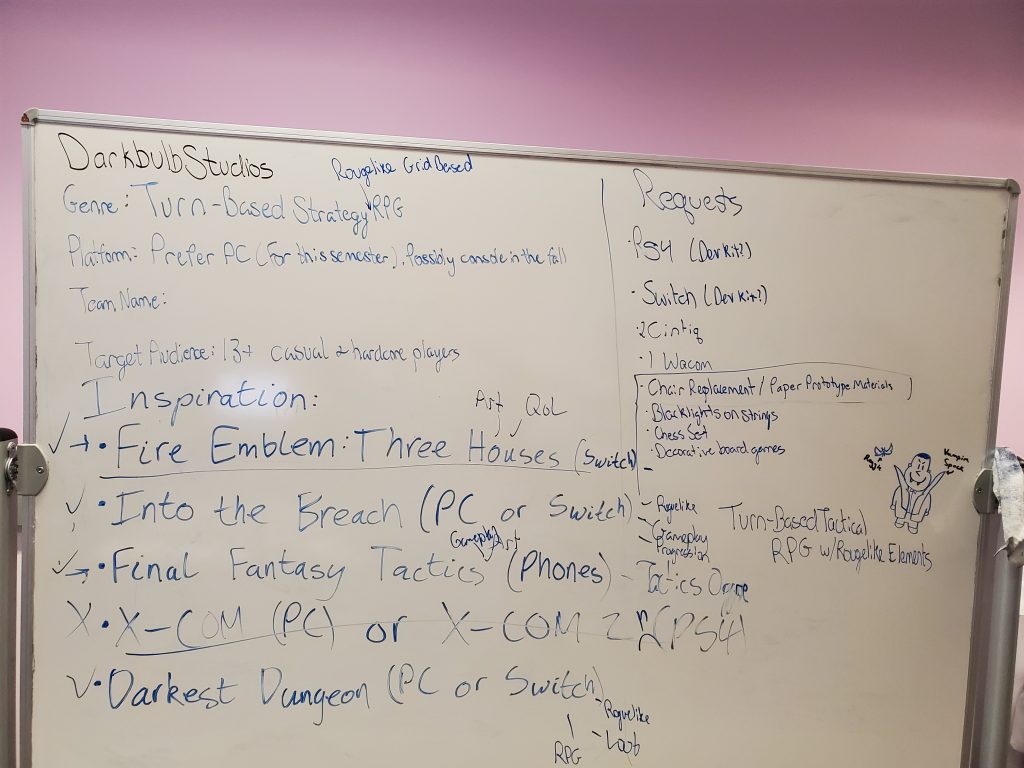Week 1 consisted entirely of high-level brainstorming for our idea. Since our project is Pre-Production for a year-long game, we did not have much of a prompt in terms of direction. We met with our faculty advisers who gave us the option of having as many or little constraints as possible. They told us that they could give us an entire idea to give us full constraints, or allow us to dive in to be as free as possible. It initially seems like an easy question to answer. Why would you ever choose to have the freedom of creativity taken away from you? They then gave us a warning that going completely free can lead to a lot of unexpected issues of deciding factors such as genre, target demographic, and platform. All of the time spent deciding that could be used to begin working if we were given these as constraints from the beginning.
We all sat down to talk to see what approach we believed would be best to use for our team. We began by asking “If you had the choice what type of game would you want to make?” Surprisingly enough, we had half of our team answer a tactical strategy game and the other answer RPG. So, we could easily combine to be a tactical RPG, similar to games like Fire Emblem or Final Fantasy Tactics. We also all decided that we wanted to go for a more stylistic fantasy setting for our game. Since it only took us a total of five minutes to decide on a genre and a broad setting, we decided that we could most-likely figure out the rest just as easily. We let our advisers know that we decided to choose the free route, and begun to figure out the rest.

So we knew what genre of game we wanted to make, so what should we decide on next? Target Audience? Story? Setting? We sat down to try to figure out where to start. We started by asking why this genre appealed to everyone in the first place, and what games got you into the genre. After getting some pretty vastly different answers among the group, we ended up at a place with not much to work with. We then threw around the idea of making a tactical RPG whose purpose would be to bring newcomers into the genre. We all may not have connected with why we love the games, but we know we love them. Let’s make a game that attempts to let others fall in love with the genre we all already do!
We also decided to pick a few games we wanted to use as inspiration for our project, and began to research each one to dig into their design. We choose Fire Emblem: Three Houses, Into the Breach, Darkest Dungeon, and Final Fantasy Tactics. We had our Designers play through the games to grab aspects they liked and did not like, then came together to discuss our findings. We wanted to find out what we felt about each game, good and bad, in order to see what we would want to (and not to) carry over into ours. Our artists also started creating moodboards for the style of fantasy they wanted to create to begin to get a visualization for our game. They took images from both games and paintings to get a feel for the color palette and style they wanted to create.
Then we had a genre and tentatively had an audience, so let’s start with our world and story! This is where our mindset from our Immersion Semester at the ETC got us in trouble. In this semester, we essentially worked under the mindset of rapid prototyping. We would have crazy short deadlines to make something that worked and was fun (usually 2 weeks), so we are all used to working under these constraints. This is a complete foil to the idea of pre-production, so we were in conflict with the core of our project. We began to rush to try to come up with a rough story, brainstorm mechanics such as adding roguelike elements to the game, and try to pick a setting. We did not have much of a reason as to why we were pitching what we were (other than it being cool), so we did not know what would be a good or bad approach. This led us to spend a lot of time brainstorming concepts and ideas that had no reason behind them. We ended the week with a strong idea in genre, but a jumbled mess of ideas for essentially everything else.
